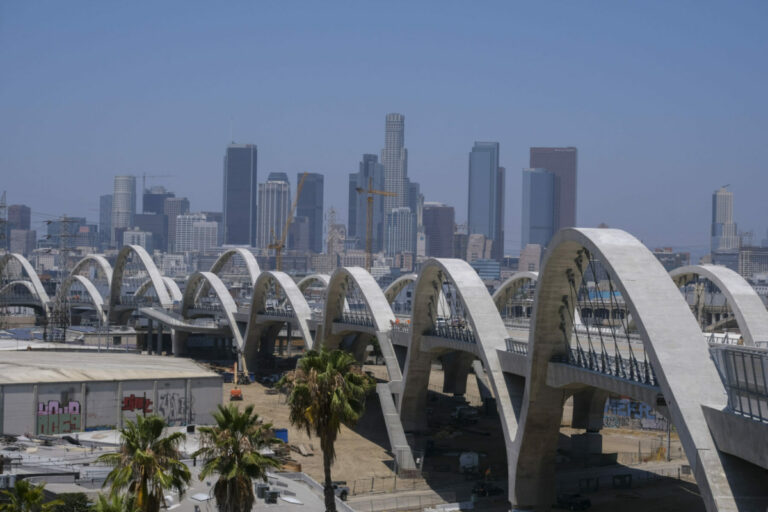
This past weekend was slated to see major milestones for two iconic bridge crossings in Los Angeles County.
On the eastern edge of downtown, the replacement for one of those bridges – the Sixth Street Viaduct – was set to open July 9 and take its place as an iconic structure.
Meanwhile, at the Port of Long Beach, another significant bridge was slated to come down: the 53-year-old Gerald Desmond Bridge. The larger replacement bridge was opened in October 2020.
Coming in at $588 million, the Sixth Street Viaduct replacement span was the largest bridge construction project in the history of the city of Los Angeles.
The original viaduct opened in 1932 as a connection between what’s now the Arts District on the west side of the Los Angeles River and the historic neighborhood of Boyle Heights on the east side. It spanned nearly 3,500 feet across the river and was often used to represent Los Angeles’ grittier side in movies, videos and TV shows. But time literally ate away at the span as a chemical reaction in the concrete caused deterioration in the bridge structure. Because it also needed to be seismically upgraded, the city’s Bureau of Engineering set to work creating a replacement crossing.
The main unique feature from the design team for the new bridge — consisting of Kansas City, Missouri-based HNTB Corp. and Los Feliz-based Michael Maltzan Architecture Inc. — was a series of 10 sweeping arches on each side of the bridge, creating a nighttime effect called the “ribbon of light.”
While Maltzan Architecture was busy creating the arches, HNTB was tasked with making sure the bridge had all the latest seismic mitigation equipment.
According to HNTB’s project manager and principal engineer Michael Jones, the arches posed a significant obstacle to traditional seismic isolators because they extend below where the isolation bearings would typically be placed.
HNTB turned to Vallejo-based Earthquake Protection Systems Inc. to come up with the new design.
Once the design was developed, the new seismic isolation devices were installed by the project’s construction team, led by a joint venture of Skanska USA Inc., a unit of Stockholm, Sweden-based Skanska, and Stacy and Witbeck Inc. of Alameda.
Meanwhile, at the Port of Long Beach, the back channel was slated to be closed July 9-10 to accommodate the removal of the main 410-foot span of the old Gerald Desmond Bridge over that channel. This is the first step of the $59.9 million demolition contract that the port awarded last July to Kiewit West Inc. (a unit of Omaha, Nebraska-based Kiewit Corp.), to dismantle and remove main truss spans, steel plate girder approaches, abutments, foundations and other pieces of the old bridge.
“The Gerald Desmond Bridge served Southern California’s regional transportation network for over 50 years, carrying more than 60,000 Southern California commuters and cargo-hauling trucks every day by the time construction started on the new bridge,” Steven Neal, president of the Long Beach Board of Harbor Commissioners, said in the announcement of the back-channel closure.
Assuming that main span was removed on schedule, the replacement bridge, which crosses the channel at a level 50 feet higher, can now serve all elements of its purpose, nearly two years after it opened to vehicular traffic. With the old crossing gone, larger cargo ships now have enough clearance to pass under the replacement bridge. Until now, those ships have been blocked from accessing the port’s inner harbor.
